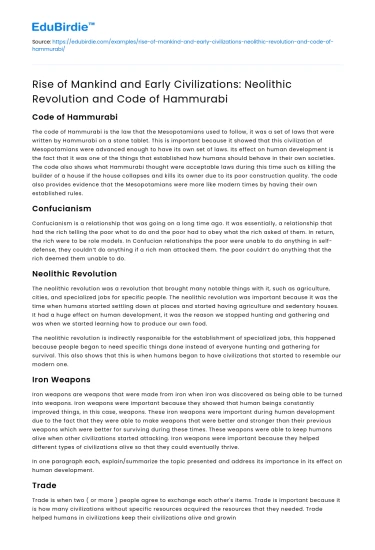Introduction
The Neolithic Revolution and the Code of Hammurabi represent two pivotal moments in human history, each fundamentally altering the structure and functioning of societies. The Neolithic Revolution, dating back to around 10,000 BCE, marked the transition from nomadic hunter-gatherer communities to settled agricultural societies. This shift facilitated population growth, technological innovation, and the establishment of complex social structures. In contrast, the Code of Hammurabi, enacted in the 18th century BCE by the Babylonian king Hammurabi, was one of the earliest written legal codes. It underscored the development of centralized governance and the rule of law in burgeoning urban civilizations. By examining these two milestones, we gain insight into the evolutionary trajectory of human societies from primitive communities to sophisticated states. This essay explores how the Neolithic Revolution and the Code of Hammurabi shaped social, economic, and legal paradigms, analyzing their transformative impacts while considering counter-arguments that challenge their significance.
The Neolithic Revolution: Catalysts of Change
The Neolithic Revolution, a watershed moment in human history, fundamentally reshaped societies by altering their subsistence strategies and social structures. As humans transitioned from foraging to farming, they began to cultivate crops and domesticate animals, which brought about significant demographic changes. The ability to produce surplus food led to population growth and the development of permanent settlements. This transition is exemplified by archaeological findings at sites like Çatalhöyük in modern-day Turkey, where evidence of early urban planning and communal living has been unearthed (Hodder, 2006).
Save your time!
We can take care of your essay
- Proper editing and formatting
- Free revision, title page, and bibliography
- Flexible prices and money-back guarantee
Moreover, the Neolithic Revolution spurred technological advancements, including the invention of new farming tools and techniques, which enhanced agricultural productivity. The increased food supply allowed for the specialization of labor, giving rise to diverse crafts and trades. This division of labor fostered economic complexity and the establishment of trade networks, thereby facilitating cultural exchange and the diffusion of ideas across regions. However, some scholars argue that the Neolithic Revolution also had downsides, such as social inequality and environmental degradation. The stratification of society into classes, with elites controlling resources, emerged as a byproduct of sedentary life (Diamond, 1997). Despite these criticisms, the Neolithic Revolution was undeniably a catalyst for profound social and economic transformations that laid the groundwork for the development of civilizations.
The Code of Hammurabi: A Cornerstone of Legal Evolution
The Code of Hammurabi stands as a seminal artifact in the history of law, illustrating the evolution of legal systems in ancient civilizations. This comprehensive set of laws, inscribed on a stone stele, encompassed various aspects of daily life, including trade, property rights, and family relations. The code is renowned for its principle of retributive justice, famously encapsulated in the dictum "an eye for an eye" (Hammurabi, ca. 1754 BCE). This legal framework sought to maintain social order and deter criminal behavior through clearly defined punishments.
Importantly, the Code of Hammurabi represented a shift toward centralized governance, where the state assumed the role of arbiter in disputes, thereby reinforcing the authority of the monarchy. It also set a precedent for the codification of laws, influencing subsequent legal traditions in regions such as the Near East and the Mediterranean (Van De Mieroop, 2005). However, critics argue that the code was inherently biased, favoring the elite and perpetuating social hierarchies. For instance, the penalties prescribed varied based on the social status of the offender and the victim, reflecting societal inequalities.
Despite these criticisms, the Code of Hammurabi was a cornerstone in the development of legal thought, illustrating the shift from customary to codified law. Its legacy endures, highlighting the importance of legal frameworks in fostering societal stability and cohesion.
Conclusion
In conclusion, the Neolithic Revolution and the Code of Hammurabi were transformative events that significantly influenced the trajectory of human civilization. The Neolithic Revolution catalyzed the transition to agricultural societies, fostering population growth, technological innovation, and social complexity. Meanwhile, the Code of Hammurabi laid the foundation for centralized legal systems, reinforcing the role of governance in maintaining social order. While both milestones have faced criticism, such as the emergence of social stratification and legal inequalities, their impacts on societal evolution are undeniable. By examining these historical turning points, we gain a deeper understanding of how early human societies navigated the challenges of growth and governance, setting the stage for the civilizations that followed.






 Stuck on your essay?
Stuck on your essay?

